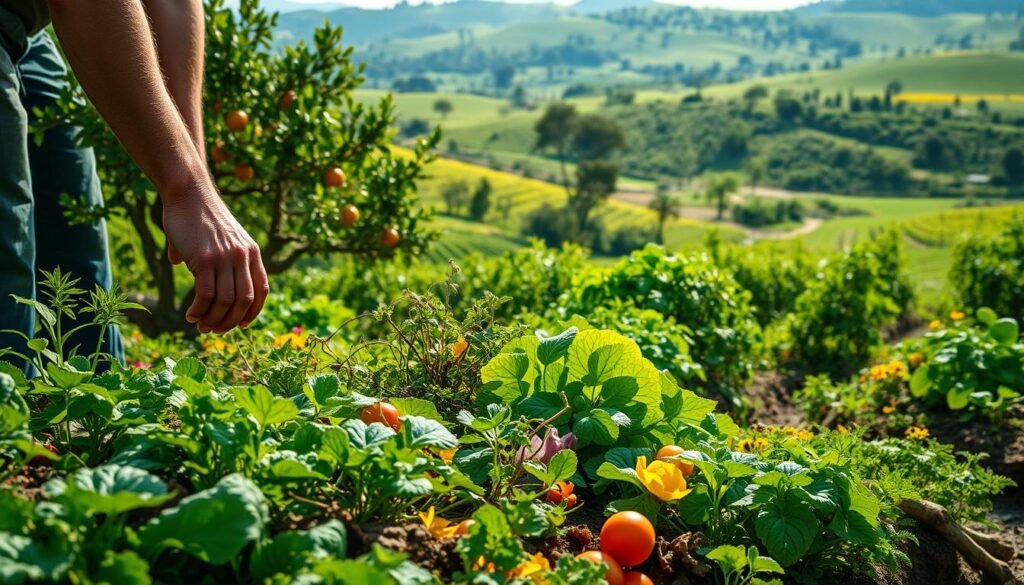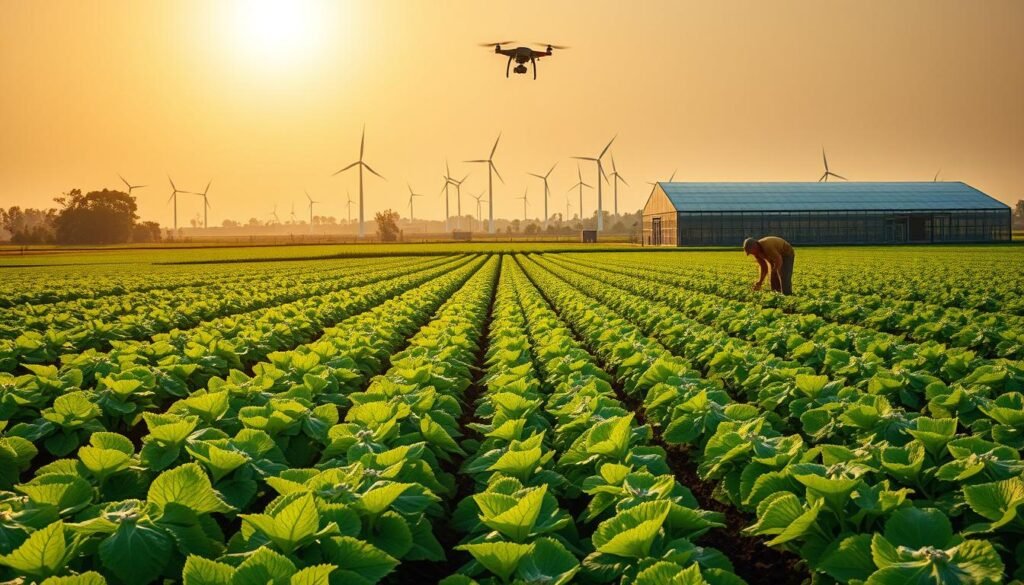Can changing how we farm really help our planet and its people? The answer is yes, through regenerative practices that are changing farming.
We’re facing big challenges like climate change, environmental harm, and health issues. So, the need for sustainable agriculture is more urgent than ever.
Regenerative farming focuses on healthy soil and natural services. It’s a hopeful way to grow food that’s good for us and the planet.
Key Takeaways
- Regenerative farming supports eco-friendly practices.
- It enhances soil health and ecosystem services.
- This approach contributes to sustainable food production.
- Regenerative farming can help mitigate climate change.
- It promotes biodiversity and environmental stewardship.
Understanding Regenerative Farming Practices
Regenerative farming is simple yet powerful. It’s about farming in a way that regenerates the soil and improves biodiversity. This approach is gaining recognition for its potential to support healthy, sustainable food systems.
What is Regenerative Farming?
Regenerative farming is an eco-friendly farming practice. It focuses on regenerating the health of the entire ecosystem. It views the farm as an ecosystem, aiming to improve soil, water, and biodiversity.
“Regenerative agriculture has the potential to reverse the damage done to the planet by conventional farming methods.” –
This method contrasts with conventional farming by promoting ecological balance. It enhances farm sustainability practices. Techniques like minimal tillage, cover cropping, and integrating organic amendments improve soil health.
Key Components of Regenerative Agriculture
The key components of regenerative agriculture include:
- Soil conservation and health improvement
- Biodiversity enhancement
- Efficient water use
- Minimal external inputs
These components work together to create a resilient farming system. For example, improving soil health through regenerative practices can increase its water-holding capacity. This reduces the need for irrigation.
| Component | Benefits |
|---|---|
| Soil Conservation | Reduces erosion, improves fertility |
| Biodiversity Enhancement | Promotes ecosystem services, improves pollination |
| Efficient Water Use | Conserves water, reduces runoff |
The Role of Biodiversity
Biodiversity is crucial in regenerative farming. It enhances ecosystem services like pollination, pest control, and soil health. By promoting biodiversity, farmers can reduce their reliance on external inputs like pesticides and fertilizers.
Regenerative farming practices that support biodiversity include planting a variety of crops. They also involve maintaining ecological corridors and integrating livestock into farming systems. These practices improve the farm’s ecological health and contribute to a more resilient food system.
Benefits of Regenerative Farming for Soil Health
Regenerative farming is becoming more popular for its benefits to soil health. It uses practices like cover cropping, crop rotation, and reduced tillage. These methods help farmers improve their soil’s health and productivity.
Improving Soil Structure
Regenerative farming is great for improving soil structure. Cover cropping adds organic matter, which helps the soil hold water better and breathe. This makes it easier for roots to grow and for beneficial microbes to thrive.
Enhancing Soil Fertility
It also boosts soil fertility. By rotating crops and using legumes, farmers naturally add nutrients to the soil. Organic amendments can further enrich the soil, avoiding the need for synthetic fertilizers.
Preventing Soil Erosion
Soil erosion is a big problem for farmers. Regenerative farming, with cover cropping and agroforestry, helps keep the soil in place. It does this by keeping the ground covered and stabilizing it with roots.
Here’s some data on how regenerative farming affects soil health:
| Practice | Impact on Soil Structure | Impact on Soil Fertility | Impact on Soil Erosion |
|---|---|---|---|
| Cover Cropping | Increases organic matter, improves water-holding capacity | Enhances nutrient cycling | Reduces soil erosion by maintaining ground cover |
| Crop Rotation | Improves soil aeration and root growth | Replenishes soil nutrients naturally | Helps in reducing erosion through varied root systems |
| Agroforestry | Stabilizes soil with tree roots | Contributes to nutrient cycling through leaf litter | Significantly reduces soil erosion |
By using these regenerative practices, farmers can make their soil healthier. This not only helps the soil but also supports a more sustainable farming system. The data shows that regenerative farming improves soil structure, fertility, and reduces erosion.
The Connection Between Regenerative Farming and Sustainable Agriculture
Regenerative farming is key to better sustainable agriculture. It makes soil healthier, boosts biodiversity, and improves ecosystems. This not only makes farms more productive but also helps the environment.
Defining Sustainable Agriculture
Sustainable agriculture means farming that cares for the environment, society, and the economy. It uses methods that save natural resources and reduce harmful chemicals. It aims for ecological balance.
Important parts of sustainable agriculture are:
- Soil conservation and health improvement
- Efficient water use
- Biodiversity conservation
- Minimizing pollution
How Regenerative Practices Promote Sustainability
Regenerative farming is a big part of sustainable agriculture. It focuses on making soil better, improving its structure, and increasing biodiversity. This leads to a healthier and more resilient ecosystem.
Regenerative farming helps in many ways:
- It helps fight climate change by increasing soil carbon.
- It keeps water in the soil and reduces erosion.
- It supports biodiversity with varied crops and habitats.
Adding regenerative farming to sustainable agriculture systems boosts environmental benefits. It also makes farms more productive and resilient. Farmers who use these methods help make our food system more sustainable.
The Role of Organic Food in Regenerative Farming
Organic food is key to regenerative farming. It boosts ecosystem services and supports sustainable farming. This method aims to heal the soil, ecosystems, and biodiversity.
What Makes Food Organic?
Organic food is made without synthetic fertilizers, pesticides, GMOs, or irradiation. Organic farming uses natural methods to keep soil fertile and control pests.
Key characteristics of organic food production include:
- Use of compost and manure to enhance soil fertility
- Crop rotation and intercropping to promote biodiversity
- Avoidance of synthetic pesticides and fertilizers
- Use of natural methods to control pests and diseases
Regenerative Farming vs. Conventional Farming
Regenerative farming is different from conventional farming. It focuses on soil health, biodiversity, and ecosystem services. Conventional farming uses chemicals and monoculture, while regenerative farming is holistic.
| Aspect | Regenerative Farming | Conventional Farming |
|---|---|---|
| Soil Health | Focuses on building soil organic matter and structure | Often degrades soil health through intensive chemical use |
| Biodiversity | Promotes biodiversity through polyculture and crop rotation | Typically involves monoculture, reducing biodiversity |
| Chemical Use | Avoids synthetic fertilizers and pesticides | Relies heavily on synthetic fertilizers and pesticides |
Gabe Brown, a regenerative farming expert, says, “Regenerative agriculture is not just about producing food; it’s about regenerating the health of the entire ecosystem.” This method supports sustainable agriculture and a healthier environment.
“The way we farm is critical to the health of our planet. Regenerative farming offers a pathway to a more sustainable future.”
Techniques Used in Regenerative Farming
Regenerative farming uses methods like cover cropping, crop rotation, and agroforestry. These practices boost biodiversity and soil health. They help create a balanced ecosystem and a sustainable farm.
Cover Cropping
Cover cropping is key in regenerative farming. It means planting crops between main crops to protect and enrich the soil. Cover crops reduce erosion, improve soil health, and boost biodiversity. They also support beneficial insects and microorganisms, vital for a healthy ecosystem.
- Reduces soil erosion by holding the soil in place
- Enhances soil fertility by adding organic matter
- Supports biodiversity by providing habitat for various species
The Rodale Institute says cover cropping can increase soil organic matter by up to 1% a year. This greatly improves soil health over time.
Crop Rotation
Crop rotation is crucial in regenerative farming. It means changing crops on the same land to avoid nutrient depletion. Crop rotation boosts soil fertility, reduces pests and diseases, and increases yields. It helps farmers avoid using harmful chemicals by breaking pest and disease cycles.
“Crop rotation is a powerful tool for maintaining soil health and promoting biodiversity. By rotating crops, farmers can create a more resilient and productive agricultural system.”
Agroforestry Practices
Agroforestry mixes trees into farm landscapes to foster ecological interactions. Agroforestry enhances biodiversity, improves soil health, and boosts ecosystem services. Trees offer shade, improve soil, and provide wildlife habitats, making ecosystems more diverse and resilient.
| Technique | Benefits |
|---|---|
| Cover Cropping | Reduces soil erosion, improves soil health, increases biodiversity |
| Crop Rotation | Improves soil fertility, reduces pests and diseases, increases crop yields |
| Agroforestry | Enhances biodiversity, improves soil health, increases ecosystem services |
In conclusion, regenerative farming’s techniques like cover cropping, crop rotation, and agroforestry are vital. They promote ecological balance and soil health. By using these methods, farmers help make agriculture more sustainable.
The Environmental Impact of Regenerative Practices
Regenerative farming helps farmers cut down their environmental impact and boost biodiversity. It’s more than just growing food. It’s about making a sustainable ecosystem that’s good for the planet and people’s health.
Regenerative farming is great for the environment in many ways. It lowers carbon emissions, saves biodiversity, and saves water.
Reducing Carbon Footprint
Practices like cover cropping and crop rotation help lock carbon in the soil. This lowers CO2 in the air. It also makes the soil healthier.
Carbon sequestration is a big plus of regenerative farming. By boosting soil organic matter, farmers can cut their carbon footprint a lot.
Biodiversity Conservation
Regenerative farming boosts biodiversity by creating homes for many plants and animals. This balance is key for farming’s long-term success.
Diverse crop rotations and organic methods increase biodiversity. They also make farms more resilient against pests and diseases.

Water Conservation Benefits
Regenerative farming also saves water by making soil hold more moisture. This means less need for irrigation and healthier water cycles.
Cover cropping and mulching keep soil moist. This cuts down on runoff and makes water use more efficient.
| Environmental Benefit | Regenerative Practice | Outcome |
|---|---|---|
| Carbon Sequestration | Cover Cropping, Crop Rotation | Reduced Atmospheric CO2 |
| Biodiversity Conservation | Diverse Crop Rotations, Organic Practices | Enhanced Ecosystem Services |
| Water Conservation | Cover Cropping, Mulching | Improved Soil Water-Holding Capacity |
Challenges Facing Regenerative Farmers
Regenerative farming has many benefits but also faces challenges. It aims to make farming more sustainable and improve the environment. However, it struggles with economic issues, knowledge gaps, and market access.
Economic Barriers
One big challenge is the cost. Starting regenerative farming requires a lot of money for new tools, seeds, and workers. It can also mean lower yields at first, which hurts farmers’ income.
Here’s a look at some economic barriers and possible solutions:
| Economic Barrier | Description | Potential Solution |
|---|---|---|
| High Initial Investment | Costs for switching to regenerative farming | Access to subsidies or grants |
| Lower Initial Yields | Yields might drop at first | Grow different crops that are more valuable |
| Limited Access to Credit | It’s hard to get credit for new farming ways | Special credit programs for regenerative farmers |
Knowledge Gaps Among Farmers
Regenerative farming needs different skills than traditional farming. Farmers must learn about cover crops, crop rotation, and agroforestry. But, there’s often not enough training or resources, leading to knowledge gaps.
Education and workshops can help. Online resources and farmer networks also offer support and knowledge sharing.
Market Access Issues
Regenerative farmers struggle to sell their products. Consumers might want to pay more for sustainable goods, but farmers need to reach them. Issues include lack of infrastructure, high shipping costs, and limited market info.
To solve these problems, farmers can try new sales methods. Direct sales to consumers through markets or online platforms are options. Building ties with local businesses and shoppers can also help.
Case Studies of Successful Regenerative Farms
Successful regenerative farms are changing the face of agriculture. They use new methods and focus on being green. These farms show how regenerative farming can make soil better, increase biodiversity, and help ecosystems. They also show that farming can be done in a way that’s good for the planet.
Notable Farms in the U.S.
In the U.S., many regenerative farms are doing great things. For example, Quivira Ranch in California uses special grazing methods. This has made the soil richer, cut down on erosion, and boosted biodiversity.
Singing Frogs Farm in California also stands out. They use cover crops and less tillage. This has made the soil healthier and helped crops grow better.
Polyface Farm in Virginia is another example. They use rotational grazing and mix different farming methods. This has made the farm healthier and more profitable.
Lessons Learned from Successful Implementations
These farms teach us important lessons. Here are a few key points:
- Diversification: Growing different crops and raising different animals can make farms stronger and more diverse.
- Soil Conservation: Using cover crops and less tillage can greatly improve soil health.
- Integrated Systems: Combining crops and animals can make farms more productive.
These examples show that regenerative farming is good for the environment and can be profitable. By using these methods, farmers can make their soil better, increase biodiversity, and help ecosystems. This helps create a more sustainable food system.
The Future of Regenerative Farming
Regenerative farming is changing the face of agriculture. It’s making our food system more sustainable and eco-friendly. As we move forward, regenerative farming will grow, thanks to new trends and tech.
Trends to Watch
Several trends are set to shape regenerative farming’s future. Precision agriculture techniques are becoming more common. They use tech to boost crop yields and cut down on waste.
The demand for regenerative organic certification is also on the rise. It ensures farming practices are transparent and accountable. Agroforestry practices are gaining popularity too. They boost biodiversity and improve ecosystem services.
Using cover crops is becoming more common. They help keep soil healthy and fight climate change.
| Trend | Description | Impact |
|---|---|---|
| Precision Agriculture | Use of technology to optimize crop yields | Reduced waste, improved efficiency |
| Regenerative Organic Certification | Promotes transparency in farming practices | Enhanced accountability, consumer trust |
| Agroforestry Practices | Integration of trees into farming systems | Increased biodiversity, improved ecosystem services |
Innovations on the Horizon
New tech and practices are always coming to regenerative farming. Regenerative farming software is being developed. It helps farmers track and manage their practices better.
Advances in biotechnology are also making crops more resilient and sustainable. This is a big step forward for farming.

Vertical farming and urban agriculture are also changing the game. They bring food closer to people and cut down on transport. These innovations will play a big role in making our food system more sustainable.
Policy Support for Regenerative Agriculture
Regenerative agriculture needs strong policy support to thrive. As we move towards more sustainable farming, policy plays a key role. It helps make regenerative farming a reality.
Government Initiatives
Government support is essential for regenerative agriculture to grow. Policies with financial help, technical support, and market access encourage farmers to adopt regenerative methods.
The U.S. Department of Agriculture (USDA) has started programs for regenerative agriculture. The Conservation Stewardship Program and the Environmental Quality Incentives Program offer financial and technical aid to farmers.
“The success of regenerative agriculture depends on our ability to create policies that support its growth.” –
Non-Profit Organizations’ Role
Non-profit groups are also key in promoting regenerative agriculture. They help farmers by offering education and resources. Groups like the Regenerative Agriculture Foundation and the Sustainable Agriculture Coalition push for policies that back regenerative farming.
- Advocating for policy changes that support regenerative agriculture
- Providing education and training to farmers
- Supporting research into the benefits and challenges of regenerative agriculture
Together, government efforts and non-profit groups can build a strong support system for regenerative agriculture. This ensures a sustainable food system for the future.
Community Engagement in Regenerative Practices
Effective community engagement is key to successful regenerative farming. It helps make regenerative farming more accepted and used by more people.
Building Local Networks
Creating local networks is vital for regenerative farming’s success. It connects farmers, consumers, and other stakeholders. Local networks help share knowledge, resources, and best practices, making regenerative farming more effective.
For example, local farmers’ cooperatives are important. They offer training, equipment, and market access to their members. They also help push for policies that support regenerative agriculture.
| Benefits of Local Networks | Description |
|---|---|
| Knowledge Sharing | Allows farmers to share best practices and new techniques. |
| Resource Allocation | Helps use resources like equipment and expertise better. |
| Market Access | Opens up better market opportunities for regenerative farm products. |
Education and Awareness Programs
Education and awareness programs are crucial for promoting regenerative farming. They can be workshops, training sessions, or outreach campaigns. By teaching consumers about regenerative farming’s benefits, communities can boost demand for sustainable food.
These programs also help farmers learn more about regenerative practices. This leads to better soil health, biodiversity, and ecosystem services.
How Consumers Can Support Regenerative Farming
Consumers have a big role in helping regenerative farming grow. By picking organic food, they help farmers who use good farming methods. These methods include cover cropping and crop rotation to make soil better and increase biodiversity.
Make Informed Food Choices
Choosing organic produce is a smart way to support regenerative farming. Organic food is made without harmful chemicals. When you shop, look for the USDA Organic label to know you’re getting quality products.
Engage with Local Farming Communities
Buying at local farmers markets is another great way to help. It keeps local farms going and encourages them to use better farming ways. Many markets now show which farmers use regenerative methods, making it easier to choose wisely.
By picking organic food and buying from local farmers, we help make our food system better. This supports farming that cares for the soil, plants, and animals. It’s good for the environment too.



